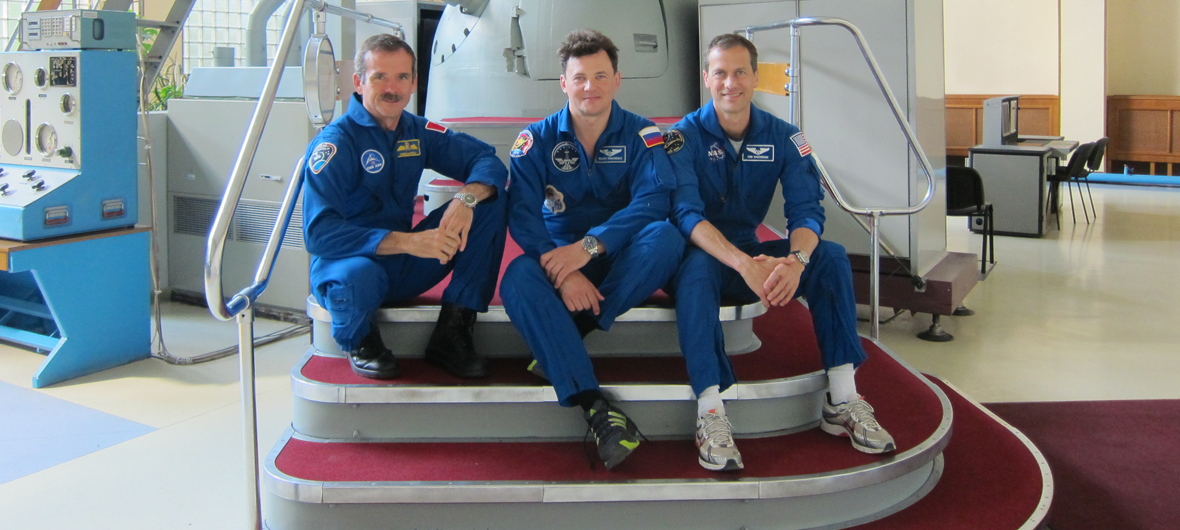Going the distance: Hadfield's overseas training
Chris Hadfield's relationship with Russia's space program has roots that run deep. As the only Canadian to have visited the Russian Mir Space Station (doing so during his first space flight in 1995), and after extensive training and work in Russia, Chris has forged lasting bonds with his cosmonaut colleagues. It is fitting that his next journey will be aboard a Russian vehicle.
Part of Hadfield's training takes place in Star City, home to the Yuri Gagarin Cosmonauts Training Centre, focusing on the duties that he'll carry out aboard the Soyuz spacecraft that will carry him to and from the International Space Station (ISS) alongside cosmonaut Roman Romanenko and NASA astronaut Thomas Marshburn. He will serve as the flight engineer, or "left seater," strapped in next to Romanenko, the capsule's commander.
As the flight engineer, Hadfield will serve as Romanenko's co-pilot during launch, docking and landing phases of the mission. He will be prepared to assume control of the spacecraft if for some reason Romanenko is incapacitated–a role that until recently was always filled by another cosmonaut.
"The Soyuz is still new to North America," explained Hadfield. "There's only a small subset in the astronaut office with the necessary combination of technical and test-piloting skills, the operational sense and the ability to converse in Russian."

Russian cosmonaut Roman Romanenko (left) and Chris Hadfield before their first suited Soyuz simulation in July 2011. (Credit: Canadian Space Agency)
Hadfield's introduction to Star City came after his second shuttle mission in 2001. Over the two years that followed, Hadfield served as NASA's Director of Operations in Russia. He coordinated and directed astronaut training, oversaw support staffing and negotiated policy changes among the Station's global partners, all while honing his Russian language skills.
As Hadfield prepared to leave the operations role, the Canadian Space Agency (CSA) found an opportunity for him to remain and train as a Soyuz flight engineer/pilot.
"The most difficult part was that there was no text book—in Russian or English. The classroom work was one-on-one with an instructor. I took copious notes," Hadfield recalled. "From a student standpoint it was a really tough year. Now, the textbooks are catching up."
In 2009, Hadfield served as the backup to astronaut Robert Thirsk, who became Canada's first long-duration astronaut on a six-month mission to the ISS that launched and landed aboard a Soyuz capsule. Though Hadfield did not fly, he trained closely with Romanenko, who served alongside Thirsk as the Soyuz commander and Station flight engineer.
"I've gotten to know Roman over the last several years," said Hadfield. "So, right from day one, we have worked together in the Soyuz."
Since May 2010, Hadfield has rotated through Star City for six to eight week-long training sessions. The rotations are interspersed with training in the United States, Germany and Japan, sessions that are preparing him to watch over the operation of the European Space Agency's Columbus and Japan Aerospace Exploration Agency's Kibo science modules and participate in their science experiments.
In 2012, Hadfield's Russian training became more focused as he serves as backup to NASA astronaut Sunita Williams and prepares for his own mission.
Hadfield is scheduled to return to Star City in mid-October 2012 for flight qualification simulations on the Station's Russian modules as well as the Soyuz. Hadfield, Romanenko and Marshburn then travel to Baikonur for the final two weeks before their launch, enough time to relax before their long journey and a final round of emergency training.
